|

by Graham Phillips
September 07, 2024
from
AncientOriginsUnleashed Website
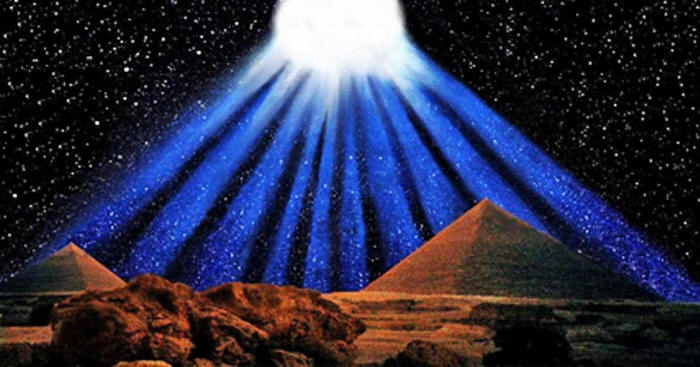
Impression of the spectacular
ten-tailed comet
recorded by the
Ancient Egyptians in 1486 BC.
(Illustration
by Graham Phillips)
On 30 September 2016, the first human spacecraft ever to orbit a
comet was deliberately crashed onto its surface in order to get the
closest possible pictures of the enigmatic celestial body.
This will end its mission that began when the
vessel was launched over twelve years ago...
During the past two years the European Space
Agency's Rosetta probe
has been
circling the comet millions of
miles from Earth,
making unprecedented close-range observations of
Comet 67P/Churyumov-Gerasimenko (named after the two
astronomers who discovered it).
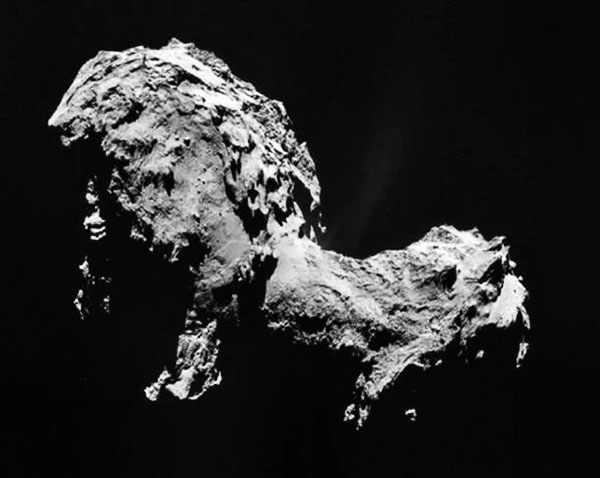
Comet Churyumov–Gerasimenko
in September
2014
as imaged by
Rosetta.
(ESA/Rosetta/NAVCAM
/CC BY-SA 3.0 igo)
One of the spacecraft's most significant accomplishments is to have
taken readings of the comet's makeup, determining that it contains
some of the basic building blocks of life.
Cometary impacts, it seems, may have helped
start life on Earth...
But comets, such as the focus of the Rosetta mission,
have also posed threats to earthly life.
67P/Churyumov-Gerasimenko is
around two and a half miles across; if it hit the Earth - which
thankfully it won't - it could put an end to civilization as we know
it.
A comet just 500 feet in diameter is believed to
have caused the
Tunguska event of 1908, when it
exploded over a remote area of Siberia with the force of a fifteen
megaton bomb, flattening 1000 square miles of forest.
But the Tunguska comet was miniscule compared to
one, estimated to have been around ten miles wide, which almost
collided with our planet three and a half thousand years ago.

Trees knocked over
by the Tunguska
blast.
(Public Domain)
Spectacular and Terrifying Ancient
Comets
This comet was recorded by the Egyptians in the 22nd year
of the reign of the pharaoh Tuthmosis III, who described it
as,
a brilliant disk much larger than the full
moon, adding that it was "a marvel never before known since that
foundation of this land" [Egypt].
Chinese astronomers, who meticulously recorded
celestial occurrences for astrological purposes, also noted the
breathtaking event.
The ancient
Mawangdui Silk Almanac,
preserved in the Hunan Provincial Museum in Changsh, depicts
the comet as one of the largest ever observed.
Not only did it fill a large part of the sky, it
had an astonishing ten tails... (The biggest comet
observed since the birth of modern astronomy, De Cheseaux's Comet of
1744, had only seven.)
The Egyptian record is found in a manuscript now in the Vatican
Library, called the
Tulli Papyrus, and a number of
writers have cited it as evidence for an ancient UFO sighting,
leading some scholars to question its authenticity.
However, it would seem to have concerned a
genuine event.
The 22nd year of Tuthmosis III's reign
is thought to have been around 1486 BC, which is precisely the year
(by our modern calendar) that the Chinese observed the
ten-tailed comet.
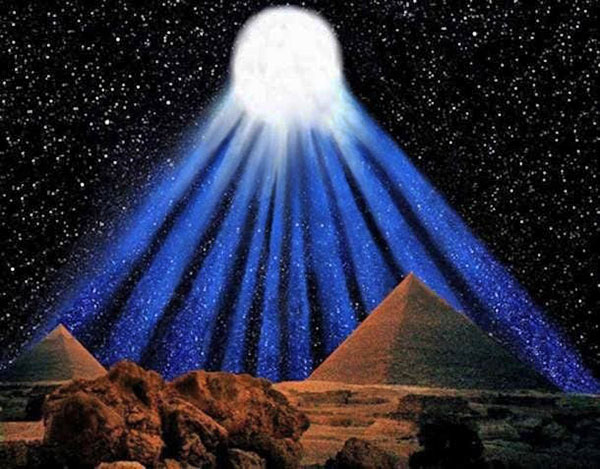
Impression of the
spectacular ten-tailed comet
recorded by the
Ancient Egyptians in 1486 BC.
(Illustration by
Graham Phillips)
The comet must have passed terrifyingly close to our planet.
Indeed, the ancient comet's appearance was so
spectacular that it seems to have had a profound influence on
religions throughout the world.
It seems that this unprecedented celestial
phenomenon was taken to be the appearance of a new god:
at this precise time, contemporary
civilizations across the globe all began to worship a new deity
depicted as a winged disk hanging in the sky.
Examples include,
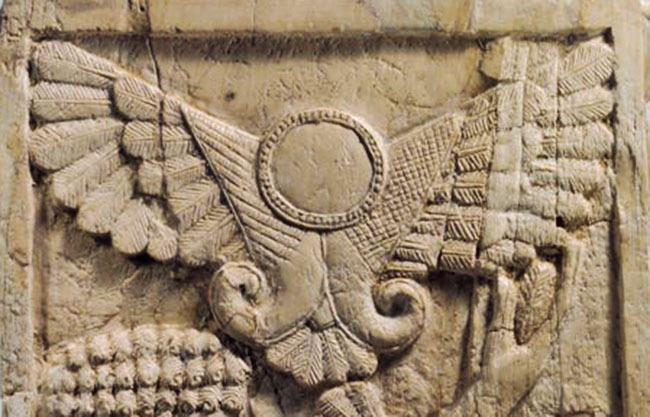
The Assyrian winged
disk.
One of the many
similar glyphs
that represented
deities that appeared
throughout the world
after
the comet's
appearance in 1486 BC.
(Public Domain)
In China, a new divinity called Lao-Tien-Yeh - "The
Great God" - appears at this time during the Sang dynasty and
was represented by a circle with a series of straight lines
radiating in a fan shape beneath and to the side of it, which looks
remarkably similar to a depiction of a comet.
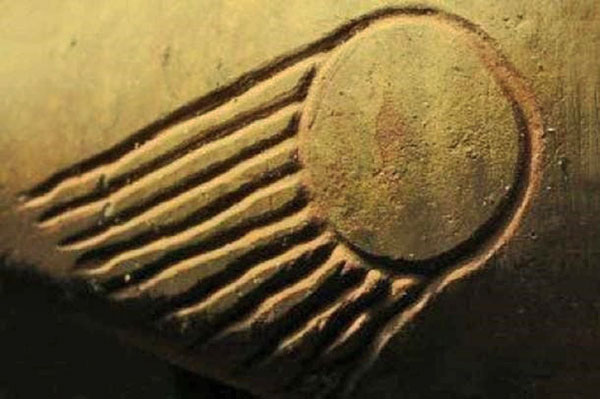
The symbol for the
god Lao-Tien-Yeh
glyph that first
appeared in China
during the early
fifteenth century BC.
(Photography by
Graham Phillips)
Fascinatingly, this glyph is almost identical to the symbol for a
new god that appeared in Egypt during the reign of Tuthmosis III.
Called the Aten, it was represented by
a circle with a fan-shaped series of lines radiating from it,
just like the symbol for Lao-Tien-Yeh.
Egyptologists have long assumed that the Aten
glyph represented the sun, which no doubt it did when the
pharaoh Akhenaten made Aten worship the state religion
in the mid-1300s BC.
But when it first appeared in the capital of
Thebes over a century earlier it is accompanied by no inscriptions
specifically associating it with a solar deity.
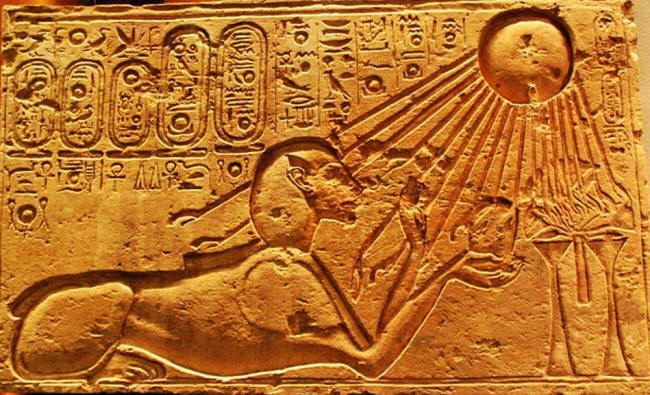
The Egyptian Aten symbol
that may
originally have depicted
the
magnificent comet of 1486 BC.
(Hans
Ollermann/CC BY 2.0)
But the sudden appearance of new religions was not the only social
upheaval to accompany the comet's close encounter with Earth.
Throughout the world, there was a simultaneous
and unprecedented period of violence.
-
Egypt embarked on a vicious military
campaign, conquering what are now Israel, Lebanon, and Libya
-
the Hittites of Turkey struck out at
their neighbors in the eastern Mediterranean
-
in Syria, the Mitanni kingdom attacked
the Assyrians of Iraq
-
the Kassites of northern Iran invaded
Babylonia in southern Iraq
-
the Yaz people of Armenia ferociously
attacked everyone around them
-
the Harappan civilization of north-west
India was wiped out by marauding tribes from Afghanistan...
And all this followed a period of relative peace
throughout the world that had lasted for generations.
Experts generally believe that the period of intense warfare and
social unrest around the world was due to a short term climate
change that saw global temperatures drop.
Resultant crop failures meant the kind of scarce
resources that invariably lead to conflict.
The question, however is,
what caused the bad weather that lasted for a
decade or so..?
Threats to Life and Civilization
In 1985 astronomer
Carl Sagan identified the comet
of 1486 BC as
Comet 12P/Pons-Brooks,
suggesting that a fragment of it had broken off and impacted with
the Earth, the resultant explosion throwing debris high into the
atmosphere and impeding the sun's rays for many years, causing
global temperatures to fall.
But this may not have been the only effect of the
cometary impact.
At the International Conference on
Catastrophic Events and Mass Extinctions held in Vienna in July
2000, scientists gathered to discuss possible threats to life on
Earth posed by asteroid and comet impacts.
Interestingly, besides the obvious calamities such impacts would
cause, such as,
firestorms, nuclear winters, and tsunamis,
attention was drawn to various harmful chemicals that some
comets contain.
One of these is the amino acid
vasopressin that can cause
violent and aggressive behavior in humans.
It is not at present known if 12P/Pons-Brooks
contains vasopressin, but if it does,
then the substance entering the atmosphere to
contaminate the food chain could in part have been responsible
for the unprecedented period warfare that griped the
planet in the early 1400s BC...
|








